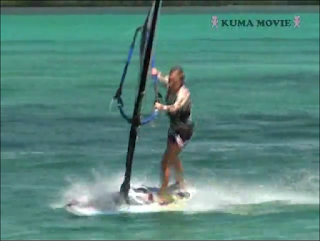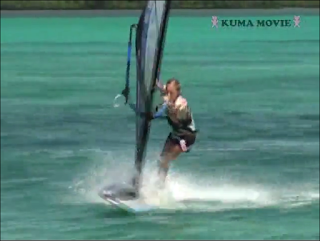Before I go into any more details, let me show you a Flaka very similar to the one I saw in Bonaire a few years ago which started this whole thought process. This is a short part of the "Girls in Bonaire by Kuma Movie" video:
- It is obvious that the move is very similar to an upwind 360, which can be practiced in light wind
- The difference is that it starts with a small jump (or rather pop), but as the video shows, turning the board about 45 degrees in the air is sufficient.
But looking at this movie and other Flaka movies also shows some subtleties that may explain what can make the Flaka a hard move to learn. For the rest of this discussion, I will focus on the first half of the move, until the board is sliding backwards. The second part is identical to the second part of an upwind 360, and therefore should be reasonably easy to do if you have a solid upwind 360.
At least for Flakas with a small initial hop (less than 180 degrees), there are several changes in how the board is railed during the move. The Flaka is typically initiated with a downwind carve, just like a jibe entry, so we pressure is on the toes. For the takeoff, the board is flat:
In this example, the board is back in the water after turning only about 45 degrees:
The tail of the board needs to slide towards downwind, so the weight must be on the heels - otherwise, the toe-side rail would catch, resulting in a crash onto the sail. The "heel-side rail down" can be seen even better on the next picture:
The board continues to slide around until it has turned 180 degrees:
Note that the sailor's weight has moved towards the nose of the board. The back leg is straight, the front leg bent:
Now, the board is relatively flat. The sail is about to be backwinded. Everyone who has ever taken an ABK camp knows that the sail pressure needs to be on the toes for backwinding, and that's what we see:
The board is now angled so that the heel-side rail is up. The sail is backwinded and pushed towards the nose, so it wants to push the nose around. In an upwind 360, we would now move the weight onto the back foot to move the waterline, and this seems to be exactly the same in the Flaka:
In this example, the weight shift may be a bit more than necessary, so she over-rotates a bit. But you can see exactly the same shifts in this movie where Daida Moreno does a very nice Flaka.
To summarize, the Flaka as shown above includes the following weight shifts:
- toe-side => flat => heel side => flat => toe side
- weight centered over the board => weight towards nose => weight on back foot
So, there seems to be a lot more going on than one might think at first glance. If you watch Flakas from some of the top guys, some of the elements above may not be visible. That's partly because they often jump the board a full 180 degrees before it hits the water again, so the initial heel-side slide is not present. But I think many windsurfers learning this move will start with jumps that are significantly less than 180 degrees, and therefore need some heel-side slide.
The entire thing about the rail setting was brought to my attention by my lively wife, and is based on what she heard in a Flaka discussion with ABK Boardsport's Brendon. It makes perfect sense to me after working on 360s a few times in "pesky" winds (around 15 mph), where exact technique is essential. However, I have not seen it mentioned much in Flaka lectures or discussions.
I think the rail-to-rail dynamics may explain the problems that some freestylers who can Vulcan have when learning the Flaka. Unlike the Flaka, which can be done with a relatively small initial jump, the Vulcan pretty much requires a 180 degree jump. While both moves do include a backward slide, the move mechanics otherwise are very different, and learning one move first may actually make learning the other move harder.
There is one more thing that has fascinated me about the Flaka: the similarity of the first half of the Flaka with the jibe. That may sound crazy, since the jibe is a downwind turn and the Flaka start in an upwind jump, so let me explain with some pictures:
On the left side, we have Anders Bringdal entering a step jibe; on the right is Daida Moreno entering a Flaka. They both start carving downwind, getting the sail depowered and behind them, and have the head on front of the mast. There are some differences because Anders is on slalom gear in a lot more wind, but I ask you to ignore these and focus on the similarities.
This is a bit further into the moves. We can see that the boards are starting to point into different directions, but the sail and body positions are pretty similar, with the sail in front of the body, and the shoulders more or less square to the sail.
A bit further into both moves, we again see both sails in the same position, with the mast towards the viewer. Anders is about to rotate the sail, Daida is about to get backwinded to finish the rotation. Even though Anders is looking forward and Daida is looking to the back, their body positions are similar. The original back foot is now in front, and the shoulders are pretty square to the sail.
From the pictures above, we can conclude that the first half of the Flaka is very similar to a jibe! Except for the jump/pop, sail and body move in a very similar fashion in both moves. The obvious difference is that the feet remain in the straps for the Flaka. So to rotate the body by 180 degrees, and have the old back foot go to the front, we have to pop the board out of the water. Then, instead of stepping forward, we rotate the body 180 degrees, taking the board with is. I this this analogy gets even more amusing when we think about the Flaka 180 instead of the Flaka. In the Flaka 180, the sail is flipped like in a heli tack while sliding backward, and we start sailing back into the direction from where we came. So the Flaka 180 is really the upwind equivalent to the downwind Vulcan. It can be also seen as a heli tack that starts with a jump-turn. And based on the above, that's very similar to a jibe :-)









